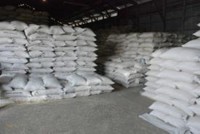

The commonly
accepted view is that rice was first domesticated in the region of the
Yangtze River valley in China. Morphological studies of rice phytoliths
from the Diaotonghuan archaeological site clearly show the transition
from the collection of wild rice to the cultivation of domesticated
rice. The large number of wild rice phytoliths at the Diaotonghuan level
dating from 12,00011,000 BP indicates that wild rice collection was
part of the local means of subsistence. Changes in the morphology of
Diaotonghuan phytoliths dating from 10,0008,000 BP show that rice had
by this time been domesticated. Soon afterwards the two major varieties
of Indica and Japonica/Sinica rice were being grown in Central China.
In the late 3rd millennium BC, there was a rapid expansion of rice cultivation
into mainland Southeast Asia and westwards across India and Nepal.
In 2003,
Korean archaeologists claimed to have discovered the world's oldest
domesticated rice. Their 15,000 year old age challenges the accepted
view that rice cultivation originated in China about 12,000 years ago.
These findings were received by academia with strong skepticism, and
the results and their publicizing has been cited as being driven by
a combination of nationalist and regional interests. In 2011, a combined
effort by the Stanford University, New York University, Washington University
in St. Louis, and Purdue University has provided the strongest evidence
yet that there is only one single origin of domesticated rice, in the
Yangtze Valley of China.
The earliest remains of rice in the Indian subcontinent have been found
in the Indo-Gangetic Plain and date from 70006000 BC though the earliest
widely accepted date for cultivated rice is placed at around 3 0002500
BC with findings in regions belonging to the Indus Valley Civilization.
Perennial wild rices still grow in Assam and Nepal. It seems to have
appeared around 1400 BC in southern India after its domestication in
the northern plains.
According to Zohary and Hopf (2000, p. 91), O. sativa was recovered
from a grave at Susa in Iran (dated to the 1st century AD) at one end
of the ancient world, another domestication of rice in South Asia.
Today, the majority of all rice produced comes from China, India, Indonesia,
Pakistan, Bangladesh, Vietnam, Thailand, Myanmar, Philippines, and Japan.
Asian farmers still account for 92% of the world's total rice production.
